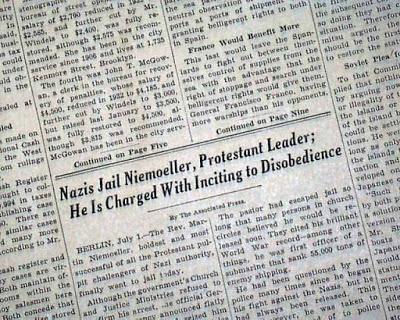
New York Times, 2 July 1937, p. 1, col. 6-7
It's the late 1980s or possibly early 1990s. I'm at my first full-time teaching job in the theology department of Xavier University in New Orleans.
When my colleague comes to work one morning, eyes blackened, face bruised all over, limping, we rush to him to ask what has happened, how we might help.
Assaulted by a gang of young men, he tells us. They jumped on me in a parking lot of a shopping center as I was heading to my car. I got away from them by rolling under the car.
This was a small man, someone who could easily roll under a car under such circumstances.
What no one says: this was a gay bashing.
What no one says: we know that this colleague is gay.
What no one says: I am gay; you are gay; we are gay.
There are no gay people at our Catholic university. No one on the faculty of this Catholic university is gay. Gay people do not exist. Not here.
No one can be gay-bashed when no one is gay.
And then, one by one, young men on the faculty begin to die of AIDS, men whose gay lives had never been acknowledged in our Christian community and whose gay names had never been spoken in our Christian community. Nameless and faceless human beings do not suddenly have names and faces just because they die.
This is how life was in every Catholic university of which I had any knowledge only three decades ago. There were no gay people on the faculties or staffs of Catholic universities — not even as nameless and faceless people began dying of a disease that, in the rest of the world, started conversations about how nameless, faceless gay folks are all around us, and deserve to have their humanity recognized if it's a humane world we want to build.
Teaching at Catholic universities, I sat or stood in silence I do not know how many times at faculty gatherings at which hateful fag jokes were cracked, venom-laden stories told about "that old homosexual Reynolds Price swirling around in his cape" or "Well, you know how those men are, and what they do to students if we don't weed them out of our schools."
"I refuse to play chess with those chess pieces — not when one of them looks like a little queer," said the colleague whose grandfather was a leading African-American intellectual who wrote brilliantly about the horrific burden people of color bear when they have to live split between a dominant white culture and their black identities. She wanted me to hear what she said. She repeated it as she stood in line behind me while the university community waited for Pope John Paul II to arrive and sing the Salve, Regina with us:
Ad te suspiramus, gementes et flentes
in hac lacrimarum valle.
Eia, ergo, advocata nostra, illos tuosmisericordes oculos ad nos converte.
We must not deceive ourselves: it can happen again. In a heartbeat. We can find ourselves back in those dark days when unacknowledged, hidden, despised members of the human race lived and breathe and worked right beside us but had no faces and no names.
The testimony of Moshe Kantor this Holocaust Remembrance Day:
Only a small minority supported Hitler’s plan to kill all European Jews through mass extermination, a plan that was widely circulated years before.
But he was able to act because an undercurrent of hatred had seeped into everyday life.
The testimony of Peter Hayes this Holocaust Remembrance Day:
Adolf Hitler was a minority choice to lead his country; when he took office, roughly 55 percent of Germans had never voted for him. Anti-semitism was prevalent in German culture but by no means dominant or respectable. . . .
Populist movements, on their own, can't make persecuting societies or generate genocides. These phenomena need office-holders to countenance, stimulate, and implement hatred. Only when powerful leaders choose to let discrimination and violence take hold, and then to accelerate these lusts, does systematic degradation, let alone mass murder, result.
It can happen again. It will happen again. In a hearbeat. If we allow it to happen.

